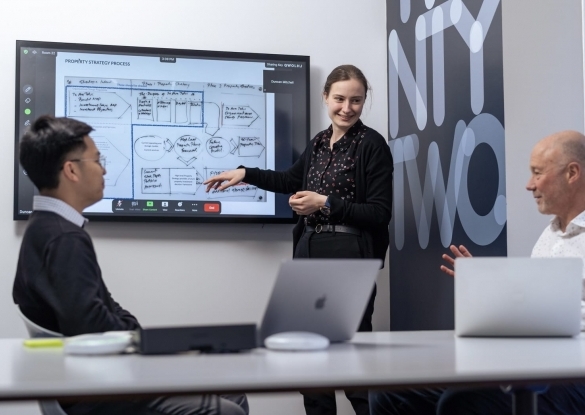In 2020, the way we work changed dramatically. Suddenly we were forced to work from home, away from our colleagues and the company that employs us. While most of us had heard of Skype for Business, Microsoft Teams and Zoom – and even used them occasionally – they were not the key work tools we used on a daily basis. And then suddenly, we were forced to figure them out because we had no other way to interact with others, both in our own business and with external clients.
It is being said that the Covid-19 disruption has brought forward these new ways of working by as much as five years. In parallel with this, many of our people want and expect to now work in more flexible ways.
Our experience is that many businesses have been caught out by this rapid change and are struggling to catch up.
Virtual collaboration systems have also been rapidly changing. During the Covid-19 disruption, Microsoft and Zoom invested heavily in advancing these systems. In some ways, the only things now holding people back from working in these new ways are management decisions and the ability of people to manage distributed teams.
However, the setup of the Audio-Visual technology and infrastructure to optimise the Teams and Zoom platforms has a major part to play in enabling these new ways of working. This blog outlines the three major phases of evolution of virtual collaboration tools and the features that can be enabled at each stage.

View and download the above infographic here
What has been happening?
Phase 1 – The Past
Over the years, many of us have been involved in video conferences. When introduced in the early 2000s, these were a revolution. We could meet people in other places and not have to waste time flying. While revolutionary at the time, the technology had many shortcomings. The system relied on propriety equipment at each end, such as Polycom. There was incompatibility as the systems didn’t talk to each other and it was also clunky to use. How many times was the first 15 minutes of the meeting wasted trying to get the video conferencing working? We had to call IT support and sometimes that worked, but sometimes it didn’t.
While video conferencing gave some level of virtual collaboration, the experience was fairly limiting – okay for transactional meeting but a long way from a truly collaborative experience.
Then, from 2005 to 2010, Skype came along and for the first time we could call our friends and family and see them on our computer screen. Business was slow to allow the use of Skype until Microsoft bought it and developed it into Skype for Business in 2015. Over time, Skype for Business was refined into Microsoft Teams and the Zoom platform was launched.
During the Covid lockdowns, these systems saved us. We were able to continue to work even when we were confined to our homes. They worked well for one-to-one interactions or team interactions when everyone was on their computers. However, when we got back to the office, trying to connect these systems into the AV technology in our meeting rooms was difficult, resulting in similar problems to the video conferencing systems they replaced. It was also difficult to manage meetings when some people were in a meeting room in the office and some at home on the computers.
Phase 2 – The Now
Microsoft and Zoom have continued the development of their virtual collaboration systems. This has led to the concept of Teams or Zoom rooms where the one-to-one virtual collaboration experience is scaled up to make the meeting room to meeting room or meeting room to single user interaction experience easy to use and more collaborative. The importance of these changes is that teams can now interact with a much better collaborative experience, independent of whether they are working from home on that day or in the office with their team. This is the essence of our new ways of working, loosely described as “flexible working”.
In many businesses, the IT teams haven’t caught up with this advancement, requiring people to connect their computers into the existing AV equipment, either wirelessly or via cables. This is adding complexity and risk to the online experience, leading to a similar experience to take of video conferencing.
Having set up a Zoom or Teams room, there are multiple features that can be turned on to enhance the collaborative experience. These include:
- One touch joining via calendar
- Wireless content sharing
- Camera control
- Interoperability between Zoom and Teams platforms
At the leading edge of features currently available to further enhance the larger group collaborative experience are:
- Dual screens
- Advanced document sharing
- Shared whiteboards
- Far-end control
Some of these require additional AV equipment and room customisation but the features are available now.
Phase 3 – The Future
Movies anticipate the technology of the future. They have for some time been showing us visions of a truly immersive, virtual meeting experience based on holographic images and AI-directed meetings. Systems that support these are not here yet, nor is the high bandwidth infrastructure required to support it.
In the near future, we can expect the availability of a Virtual Meeting Assistant to take notes, run the agenda and undertake other activities like booking future meetings. This will free up the participants to concentrate on the collaboration activities, the primary purpose of the meeting. We expect this next step to be available soon and be created within the existing Teams and Zooms platforms. It is also likely to use current Audio-Visual and room equipment.
In the slightly more distant future, we can expect a larger step change to a much more realistic virtual meeting experience created by holographic images and avatars. This will allow us to truly collaborate, independent of place. While we have seen this in the movies, the technology platforms, equipment and required infrastructure are still under development, but probably not too far away.
Why is this important?
As Covid and other pandemics become more prevalent and their ensuing lockdowns and movement restrictions become part of our normal lives, being able to have truly rich and rewarding virtual collaborative interactions will become more and more important.
As more of our people adopt flexible working where they balance their time between working in the office with working from home, being able to continue to collaborate in the virtual world will be essential for businesses to keep working effectively.
The question for businesses is whether the training processes and management styles can keep up with the working styles that technology can enable.
Helping you make Virtual Collaboration work in your organisation
Matthew Peko-Fox, our Associate Principal of Workplace Technology, has recently been working with several clients to create Teams and Zoom rooms and introduce the more advanced features to support team-based virtual collaboration. From this, he has learnt how to get the best out of existing AV equipment and set up new virtual collaboration systems that work in simple ways.
If you want to discuss how to create simple to use virtual meeting rooms that provide a rich and rewarding collaborative experience for your people, contact Matthew to arrange a meeting.
This infographic illustrates our summary of the Virtual Collaboration Evolution.







